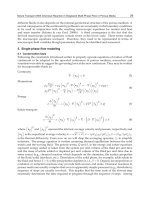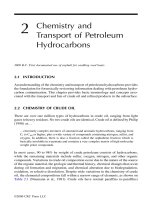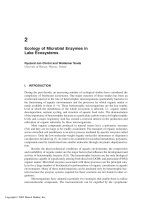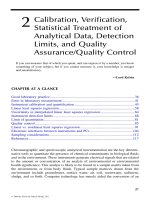Lecture Discrete mathematics and its applications - Chapter 2: Basic Structures: Sets, functions, sequences, sums, and matrices
Bạn đang xem bản rút gọn của tài liệu. Xem và tải ngay bản đầy đủ của tài liệu tại đây (19.72 MB, 137 trang )
Basic Structures: Sets,
Functions, Sequences,
Sums, and Matrices
Chapter 2
With Question/Answer Animations
Copyright © McGraw-Hill Education. All rights reserved. No reproduction or distribution without the prior written consent of McGraw-Hill Education.
Chapter Summary
Sets
The Language of Sets
Set Operations
Set Identities
Functions
Types of Functions
Operations on Functions
Computability
Sequences and Summations
Sets
Section 2.1
Section Summary
Definition of sets
Describing Sets
Roster Method
SetBuilder Notation
Some Important Sets in Mathematics
Empty Set and Universal Set
Subsets and Set Equality
Cardinality of Sets
Tuples
Introduction
Sets are one of the basic building blocks for the types of
objects considered in discrete mathematics.
Important for counting.
Programming languages have set operations.
Set theory is an important branch of mathematics.
Many different systems of axioms have been used to
develop set theory.
Here we are not concerned with a formal set of axioms for
set theory. Instead, we will use what is called naïve set
theory.
Sets
A set is an unordered collection of objects.
the students in this class
the chairs in this room
The objects in a set are called the elements, or members of
the set. A set is said to contain its elements.
The notation a ∈ A denotes that a is an element of the set
A.
If a is not a member of A, write a ∉ A
Describing a Set: Roster
Method
S = {a,b,c,d}
Order not important
S = {a,b,c,d} = {b,c,a,d}
Each distinct object is either a member or not; listing
more than once does not change the set.
S = {a,b,c,d} = {a,b,c,b,c,d}
Elipses (…) may be used to describe a set without listing
all of the members when the pattern is clear.
S = {a,b,c,d, ……,z }
Roster Method
Set of all vowels in the English alphabet:
V = {a,e,i,o,u}
Set of all odd positive integers less than 10:
O = {1,3,5,7,9}
Set of all positive integers less than 100:
S = {1,2,3,……..,99}
Set of all integers less than 0:
S = {…., 3,2,1}
Some Important Sets
N = natural numbers = {0,1,2,3….}
Z = integers = {…,3,2,1,0,1,2,3,…}
Z⁺ = positive integers = {1,2,3,…..}
R = set of real numbers
R+ = set of positive real numbers
C = set of complex numbers.
Q = set of rational numbers
Set-Builder Notation
Specify the property or properties that all members must
satisfy:
S = {x | x is a positive integer less than 100}
O = {x | x is an odd positive integer less than 10}
O = {x ∈ Z⁺ | x is odd and x < 10}
A predicate may be used:
S = {x | P(x)}
Example: S = {x | Prime(x)}
Positive rational numbers:
Interval Notation
[a,b] = {x | a ≤ x ≤ b}
[a,b) = {x | a ≤ x < b}
(a,b] = {x | a < x ≤ b}
(a,b) = {x | a < x < b}
closed interval [a,b]
open interval (a,b)
Universal Set and Empty
Set
The universal set U is the set containing everything
currently under consideration.
Sometimes implicit
Venn Diagram
Sometimes explicitly stated.
Contents depend on the context.
The empty set is the set with no
U
V a e i
o u
elements. Symbolized ∅, but
{} also used.
John Venn (18341923)
Cambridge, UK
Russell’s Paradox
Let S be the set of all sets which are not members of
themselves. A paradox results from trying to answer the
question “Is S a member of itself?”
Related Paradox:
Henry is a barber who shaves all people who do not shave
themselves. A paradox results from trying to answer the
question “Does Henry shave himself?”
Bertrand Russell (18721970)
Cambridge, UK
Nobel Prize Winner
Some things to remember
Sets can be elements of sets.
{{1,2,3},a, {b,c}}
{N,Z,Q,R}
The empty set is different from a set containing the empty
set.
∅ ≠ { ∅ }
Set Equality
Definition: Two sets are equal if and only if they have the
same elements.
Therefore if A and B are sets, then A and B are equal if and
only if .
We write A = B if A and B are equal sets.
{1,3,5} = {3, 5, 1}
{1,5,5,5,3,3,1} = {1,3,5}
Subsets
Definition: The set A is a subset of B, if and only if every
element of A is also an element of B.
The notation A ⊆ B is used to indicate that A is a subset of
the set B.
A ⊆ B holds if and only if is
true.
1.
Because a ∈ ∅ is always false, ∅ ⊆ S ,for every set S.
2.
Because a ∈ S → a ∈ S, S ⊆ S, for every set S.
Showing a Set is or is not a
Subset
of Another Set ⊆ B,
Showing that A is a Subset of B: To show that A
show that if x belongs to A, then x also belongs to B.
Showing that A is not a Subset of B: To show that A is
not a subset of B, A ⊈ B, find an element x ∈ A with x ∉
B. (Such an x is a counterexample to the claim that x ∈ A
implies x ∈ B.)
Examples:
1.
The set of all computer science majors at your school is a
subset of all students at your school.
2.
The set of integers with squares less than 100 is not a
Another look at Equality of
Sets
Recall that two sets A and B are equal, denoted by A
= B, iff
Using logical equivalences we have that A = B iff
This is equivalent to
A ⊆ B and B ⊆ A
Proper Subsets
Definition: If A ⊆ B, but A ≠B, then we say A is a proper
subset of B, denoted by A ⊂ B. If A ⊂ B, then
is true.
B
Venn Diagram
A
U
Set Cardinality
Definition: If there are exactly n distinct elements in S
where n is a nonnegative integer, we say that S is finite.
Otherwise it is infinite.
Definition: The cardinality of a finite set A, denoted by |
A|, is the number of (distinct) elements of A.
Examples:
1. |ø| = 0
2. Let S be the letters of the English alphabet. Then |S| = 26
3. |{1,2,3}| = 3
Power Sets
Definition: The set of all subsets of a set A, denoted P(A),
is called the power set of A.
Example: If A = {a,b} then
P(A) = {ø, {a},{b},{a,b}}
If a set has n elements, then the cardinality of the power
set is 2ⁿ. (In Chapters 5 and 6, we will discuss different
ways to show this.)
Tuples
The ordered ntuple (a1,a2,…..,an) is the ordered
collection that has a1 as its first element and a2 as its
second element and so on until an as its last element.
Two ntuples are equal if and only if their corresponding
elements are equal.
2tuples are called ordered pairs.
The ordered pairs (a,b) and (c,d) are equal if and only if a
= c and b = d.
Cartesian Product
René Descartes
(15961650)
Definition: The Cartesian
Product of two sets A and B,
denoted by A × B is the set of
ordered pairs (a,b) where a ∈ A
and b ∈ B .
Cartesian Product
Definition: The cartesian products of the sets A1,A2,
……,An, denoted by A1 × A2 × …… × An , is the set of
ordered ntuples (a1,a2,……,an) where ai belongs
to Ai for i = 1, … n.
Example: What is A × B × C where A = {0,1}, B = {1,2}
and C = {0,1,2}
Solution: A × B × C = {(0,1,0), (0,1,1), (0,1,2),(0,2,0),
Truth Sets of Quantifiers
Given a predicate P and a domain D, we define the truth
set of P to be the set of elements in D for which P(x) is
true. The truth set of P(x) is denoted by
Example: The truth set of P(x) where the domain is the
integers and P(x) is “|x| = 1” is the set {1,1}









